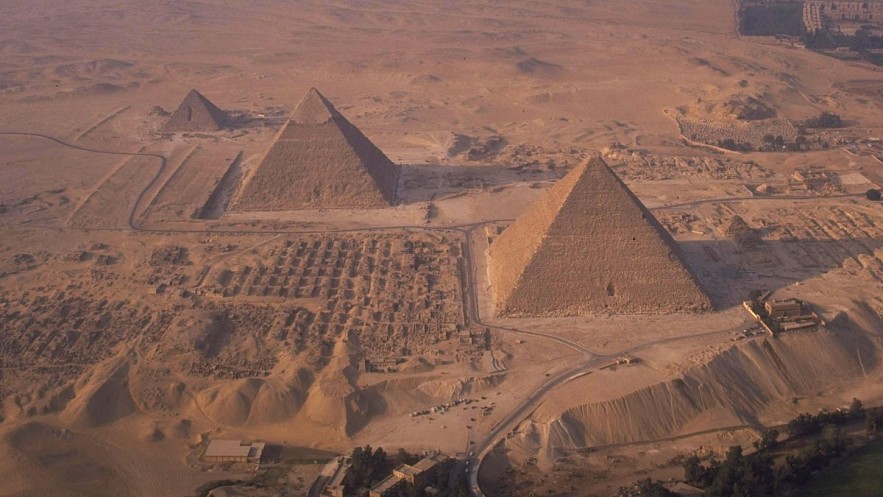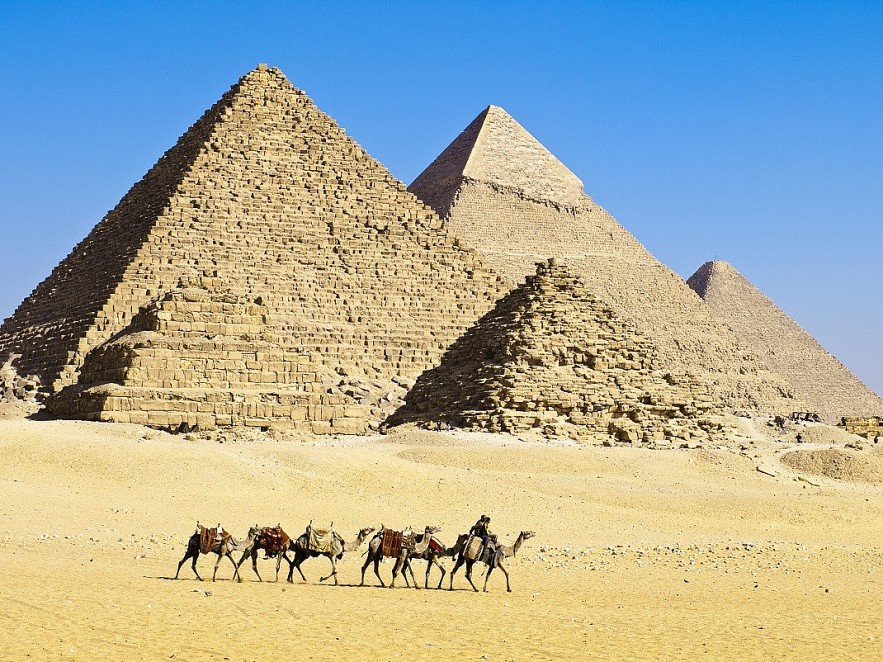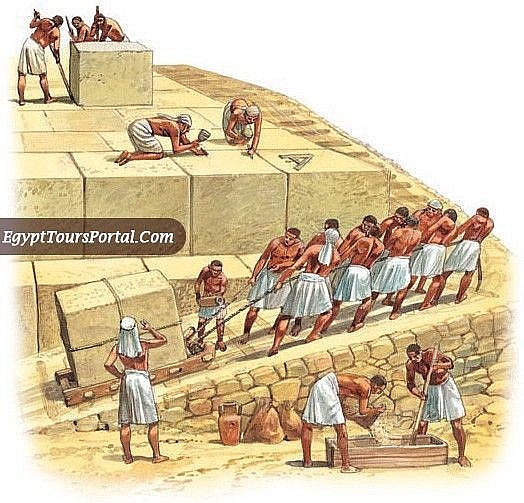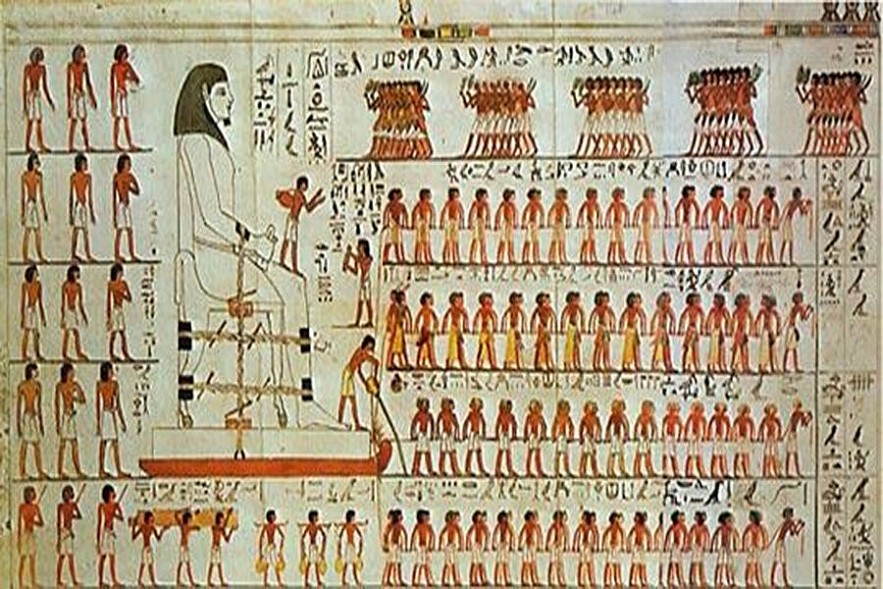How Egyptians Moved Tons Of Rocks To Build Pyramids
 |
| Solved Mystery: How Egyptians Moved Tons Of Rocks To Build Pyramids. Photo JSTOR Daily |
The forces required to pull weights onto a giant sled in the desert were studied by physicists at the University of Amsterdam, who discovered that dampening the sand in front of the primitive device reduces friction on the sled, making it easier to operate. The discoveries help to explain one of history's most enduring mysteries: how the Egyptians were able to complete the seemingly impossible task of building the famous pyramids.
| Contents |
Who built Egyptian pyramids?
The pyramids of Egypt are an archaeological wonder, rising high above the desert sands and visible for miles. Building these pyramids was undoubtedly a massive undertaking, so who were the people who succeeded?
Many theories exist about who built Egypt's pyramids, including large teams of enslaved Jewish people and far-fetched ideas like inhabitants of the 'lost' city of Atlantis or even aliens.
However, none of these theories are supported by evidence.
The pyramids could not have been built by Jewish slaves because no archaeological remains directly linked to the Jewish people have been discovered in Egypt dating back to 4,500 years ago, when the Giza pyramids were built, according to archaeological research. Furthermore, the story in the Hebrew Bible about Jews being slaves in Egypt mentions a city called "Ramesses." During the 19th dynasty (around 1295-1186 B.C. ), a city called pi-Ramesses was founded and named after Ramesses II, who ruled from 1279 to 1213 BC. This city was built after Egypt's era of pyramid construction came to an end.
| "We have no clue, not even a single word, about early Israelites in Egypt: neither in monumental inscriptions on walls of temples, nor in tomb inscriptions, nor in papyri," wrote archaeologists Israel Finkelstein and Neil Asher Silberman in their book "The Bible Unearthed: Archaeology's New Vision of Ancient Israel and the Origin of its Sacred Texts" (The Free Press, 2001). |
How many rocks needed to build Egyptian pyramids?
 |
| Photo livescience |
The 455-foot-tall Great Pyramid of Egypt is made up of an estimated 2.3 million limestone blocks. These blocks range in size from 25 to 80 tons.
In ancient Egypt, the pyramids were used to bury kings, queens, and others who could afford them. When most people think of Egypt, they think of the pyramids, which have survived for thousands of years. Egyptians needed to understand engineering, mathematics, science, and technology to build pyramids.
The towering iconic shape is often marveled at as a feat of mystery, but simply assembling the necessary materials is equally miraculous.
Over 2,300,000 giant blocks of limestone and granite weighing an average of two and a half tons had to be transported to the site from quarries, some from Aswan, more than 500 miles away, for the Great Pyramid of Giza, which is thought to have been built over a two-decade period for fourth-dynasty pharaoh Khufu.
How were the pyramids built?
 |
| Photo Egypt Tours Portal |
For many years, historians and scientists have been perplexed by the techniques used in the construction of the Egyptian pyramids. Many controversial hypotheses about the pyramids' construction have been proposed. The general theory holds that the massive stones were carved from the quarries with copper chisels. These blocks were then dragged and lifted into place. However, the method for moving and positioning these stones is highly contested.
The workforce's composition is also hotly debated. The pyramids are thought to have been built with slave labor, but another theory suggests that they were built by tens of thousands of free skilled workers who worked for a salary.
What is certain is that the workforce was highly organized and managed to the highest level by following a well-organized and planned three-phase process.
What are construction techniques of pyramid stones?• Lime stone in quarries are man made • Chemical and clay mixed with limestone to form a geopolymer lime stone and cement • Mixture carried to pyramids in 50 pound baskets mixture put into forms • Harden on site in less than 24 hours • Davidovits has made this claim for more than 40 years this makes lifting 6 million tons possible |
How Many Phases of Building the Pyramids?
To construct the pyramids precisely, the labor force relied on a methodical procedure that involved three crucial stages: selecting the ideal location for the construction, getting the site ready, and stacking the blocks.
Phase 1: Choosing the perfect building site
Selecting a suitable location was the first step in building a pyramid. Given that the Ancient Egyptians thought that the place where the sun sets was the portal to the afterlife, this had to be on the west side of the Nile, where the sun would set.
Additionally, the pyramids had to be built high on the ground, far from any potential floods during the Nile's flood. Since the river would be used to transport blocks of fine quality limestone for the outer casing from Tura on the other side of the Nile, it could not be too far from the bank of the Nile.
Given that some of the largest pyramids weigh about 2.5 tons, the location would be at a point on the plateau of the desert where it would be demonstrated that the rock bed was solid enough to support the weight of the pyramid without running the risk of breaking.
Phase 2: Preparing the site
Although no building blueprints have ever been discovered, the pyramids were not built carelessly, and a great deal of accuracy was achieved in the measurements used.
First, the workers had to clear the loose sand from the rock in order to create a solid foundation. The rock base then needed to be completely leveled. It's possible that the laborers accomplished this by constructing low mud walls around the base and creating surface-level channels arranged in a grid pattern. After that, they would mark the level at which the water would reach and fill the channels with water. Prominent rock would have been trimmed back to the designated level and any depressions filled with stones to create a perfectly level surface after the water had drained away.
One of the cardinal points had to be faced by each side of the pyramid. It's likely that the builders determined true north first and deduced the other directions from there. By observing a specific star in the northern sky, they might have been able to determine true north. Then, they would track the star's appearance and disappearance on a man-made horizon by watching it rise and set.
Phase 3: Raising the blocks
In order to save work, rocky outcrops were occasionally used as the pyramid's core. The actual pyramid would have been built around the interior passageways and chambers, which would have been built separately. It appears that some of the builders of the royal pyramids have had second thoughts about where they wanted the burial chambers to be located. After that, limestone from the desert plateau would be used to construct the inner pyramid. The pyramid was completed by covering the main structure with blocks of Tura limestone that had been finely cut and dressed. Granite was occasionally utilized for the lower courses.
The stones that were used to construct the pyramids were not tiny bricks. The pyramid's bricks are not all the same size. The largest, though, is in the King's chamber. Rather than being made of limestone like the typical blocks, these stones were composed of granite.
How Egyptians Moved Tons Of Rocks To Build Pyramids
 |
| Photo University of Amsterdam |
The University of Amsterdam researchers used hints left by the ancient Egyptians themselves to make their discovery. A wall painting from Djehutihotep's ancient tomb, dated to circa 1900 B.C., shows 172 men using ropes fastened to a sledge to move a massive statue. Professor Daniel Bonn of the University of Amsterdam, who is the lead author of the study, claimed that someone can be seen standing on the front of the sledge and sprinkling water over the sand in the drawing.
According to Bonn, "Egyptologists believed it was a purely ceremonial act," Live Science reported. "The question was: Why did they do it?"
In order to pull heavy objects through sand trays, Bonn and his colleagues built miniature sleds.
Clumps would accumulate in front of the devices when the researchers dragged the sleds over dry sand, requiring more effort to pull them across.
However, the sand became more rigid when water was added, making it easier for the sleds to move over the surface. This is because, according to the scientists, water droplets build bridges between the sand grains, aiding in their ability to cling to one another. According to Bonn, this is also the reason why making a sandcastle with wet sand is simpler than with dry sand.
The researchers did discover a delicate balance, though.
"If you use dry sand, it won't work as well, but if the sand is too wet, it won't work either," Bonn explained. "There's an optimum stiffness."
He said that the ideal amount of water varies depending on the type of sand, but it usually ranges from 2 to 5 percent of the volume of sand.
"It turns out that wetting Egyptian desert sand can reduce the friction by quite a bit, which implies you need only half of the people to pull a sledge on wet sand, compared to dry sand," Bonn stated.
 Top 10 Largest & Wonderful Pyramids In The World Top 10 Largest & Wonderful Pyramids In The World Many countries across the world are recognizable due to their unique architecture and distinguishable skylines. Let's scroll down to explore our top 10 largest and ... |
 Top 7 Oldest Pyramids In The World - The First Pyramids Top 7 Oldest Pyramids In The World - The First Pyramids For thousands of years, the largest structures on Earth were pyramids, constructed across the globe by various ancient civilisations. Here are top 7 the oldest ... |
 What is The Oldest Country: India, Egypt, San Marino or China? What is The Oldest Country: India, Egypt, San Marino or China? Which is the oldest country in the world? It's still a debate: India, Egypt, Greece, San Marino, China or Japan are potential candidates. |
























